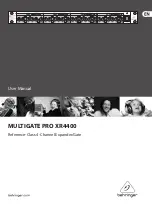
5
MULTIGATE PRO XR4400 User Manual
1. Introduction
With the BEHRINGER MULTIGATE PRO you purchased a dynamics processor of the
high-end class designed to meet highest requirements: professional recording,
broadcast and television studios, CD and digital production facilities,
etc. Its complete range of features and innovative circuit topology make
the MULTIGATE PRO an all-purpose device for reducing noise in audio
recordings, for automatically muting stage mics, expanding the dynamic
range of compressed recordings, improving the signal-to-noise ratio of noisy
communications systems and for producing special effects, etc.
Future-oriented BEHRINGER technology
Our MULTIGATE range of devices has been a hit ever since we introduced our first
model several years ago. This expander/gate is based on many years of experience
and findings in psychoacoustics and is used throughout the world in renowned
studios, sound reinforcement systems as well as in broadcast and television studios.
It was a real challenge to improve the well-known MULTIGATE even further,
and we are proud of our success. Compared to its predecessor models,
the MULTIGATE PRO not only has additional features, but also comes with
dramatically improved functionalities. For example, it now has a parametric filter
enabling you to accurately set the trigger frequencies, while the FlexLink system
allows for great flexibility when linking the device’s individual channels in a
master/slave configuration.
Basically, quadruple gates are not a new invention. However, packing four simple
noise gates into one enclosures usually means a compromise in terms of ease
of operation and functionality. Too many control elements make such a device
impossible to handle, and if you sacrifice crucial functions for the sake of easy
operation, the range of useful applications is restricted considerably.
The BEHRINGER MULTIGATE PRO is a quadruple expander/gate with a maximum
of functionalities and can still be operated conveniently. Interactive functions
make it easy and efficient to specifically process any kind of program material,
while the need for “adjustment work” has been reduced drastically. Each of
the MULTIGATE PRO’s four sections comprises an ultra-fast gate, a program-
dependent expander, a filter section and high-precision meters indicating both
threshold point and gain reduction.
The IAC circuit (Interactive Attack Control)
One of the MULTIGATE PRO’s most outstanding features is the program-dependent
control of attack times. The new IAC circuit (Interactive Attack Control) analyzes
the program material to calculate the attack time by way of interaction, so that the
hold/release process is triggered automatically depending on the program, which is
why the MULTIGATE PRO does not need a dedicated attack control.
Switchable gate/expander function
Another highlight of the MULTIGATE PRO is the switchable operating mode of
gate and expander. With the MODE function off, the MULTIGATE PRO works in
gate mode using an extremely fast attack time to gate all kinds of drum and
synthesizer sounds, without cutting their percussive edge.
In expander mode the device analyzes the shape and dynamic contents of
the input signal to calculate the control time parameters. It thus works as an
interactive expander that adapts automatically to the program signal. The result:
guitar sounds, vocals and complex mix signals can be “cleaned” without audible
clicks, breathing or other detrimental effects. Additionally, you can freely expand
any type of program material in its dynamic range.
Side-chain filter section
When several microphones are used, for example to pick up a drum set, crosstalk
between microphones can lead to unwanted triggering of the gate. The built-in
parametric sidechain filter of the MULTIGATE PRO allows the user to accurately
select the frequencies causing the trouble, so that the device responds to
these frequencies only. The monitor function can be used to pre-monitor the
filter, making it easier to adapt the circuitry to the acoustic properties of the
program material.
FlexLink system
An innovative couple function gives you great flexibility to synchronize the
expander/gate sections in a master/slave configuration.
◊
The following operational manual will introduce you to the BEHRINGER
MULTIGATE PRO and its various functions. After reading the manual
carefully, make sure it is always on hand for future reference.
1.1 Technical background
By employing current modern analog technology it is possible to manufacture
audio equipment with a dynamic range of up to 130 dB. In contrast to analog
techniques, the dynamic range of digital equipment is approximately 25 dB
less. With conventional record and tape recorder technology, as well as
broadcasting, this value is further reduced. Generally, dynamic restrictions are
due to noisy storage in transmission media and also the maximum headroom of
these systems.
1.1.1 Noise as a physical phenomenon
All electrical components produce a certain level of inherent noise.
Current flowing through a conductor leads to uncontrolled random electron
movements. For statistical reasons, this produces frequencies within the
whole audio spectrum. If these currents are highly amplified, the result will be
perceived as noise. Since all frequencies are equally affected, we term this white
noise. It is fairly obvious that electronics cannot function without components.
Even if special low-noise components are used, a certain degree of basic noise
cannot be avoided.
This effect is similar when replaying a tape. The non-directional magnetic
particles passing the replay head can also cause uncontrolled currents and
voltages. The resulting sound of the various frequencies is heard as noise.
Even the best possible tape biasing can “only” provide signal-to-noise ratios of
about 70 dB, which is not acceptable today since the demands of listeners have
increased. Due to the laws of physics, improving the design of the magnetic
carrier is impossible using conventional means.
1.1.2 What are audio dynamics?
A remarkable feature of the human ear is that it can detect the most wide
ranging amplitude changes—from the slightest whisper to the deafening roar
of a jet-plane. If one tried to record or reproduce this wide spectrum of sound
with the help of amplifiers, cassette recorders, records or even digital recorders
(CD, DAT etc.), one would immediately be restricted by the physical limitations of
electronic and acoustic sound reproduction technology.
The usable dynamic range of electro-acoustic equipment is limited as much
at the low end as at the high end. The thermal noise of the electrons in the
components results in an audible basic noise floor and thus represents the
bottom limit of the transmission range. The upper limit is determined by the
levels of the internal operating voltages; if they are exceeded, audible signal
distortion is the result. Although in theory, the usable dynamic range sits
between these two limits, it is considerably smaller in practice, since a certain
reserve must be maintained to avoid distortion of the audio signal if sudden level
peaks occur. Technically speaking, we refer to this reserve as “headroom”—
usually this is about 10 - 20 dB. A reduction of the operating level would allow for
greater headroom, i.e. the risk of signal distortion due to level peaks would be
reduced. However, at the same time, the basic noise floor of the program material
would be increased considerably.

































